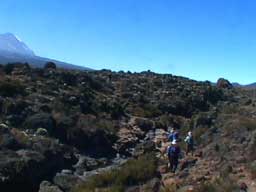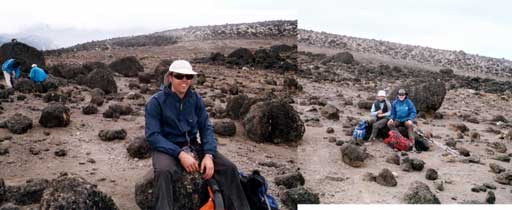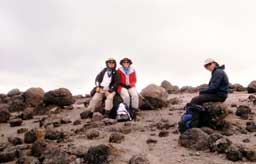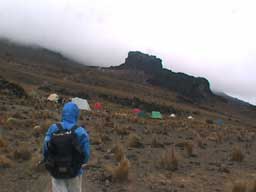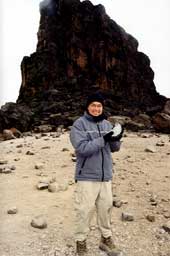Day
3 - Lava Tower |
||||||
The landscape was littered with notable features and rock formations. We walked among the notable rusted-colored volcanic rocks, perhaps ejected from some ancient eruption. Various rifts and caves, opened up over the eons, seemed like potentially inviting shelters, if needed. We had seen a Shira cave marked on the map before. While discussing where that might be with our guide Urassa, Siina asked what name the larger cave to our left had. After a pause that might prepare Urassa to say that it had no name, he suggested that it is "the Siina cave". No one was present to dispute that claim, as not another soul was to be seen except our group. We could see that we began to slowly rise out of the Shira plateau. Until then the overall climb was modest; now the slope was more decidedly upwards, but still comfortable enough. Plant life began to disappear from the terrain, replaced by more and more geologic "nodule"-like features, mostly rocks that looked like volcanic spitballs of every size. The dust, easier to kick up now with the decline in moisture, prompted us to don our bandanas. The Kibo peak, while beckoning, grew in appearance with every passing hour, becoming all the more imposing. Soon we were close enough to the base of Kibo that this mountain was almost too big to see in one look. The terrain, absent of plants, acquired a consistent slope as we worked our way around large lava formations and evidence of flows from ancient eruptions. Stacks of volcanic rock, whose artificial arrangement was obvious, marked the path before us. Rounding yet another frozen lava flow, we arrived at camp at 1 pm just below Lava Tower, an unmistakable formation of rock jutting a hundred meters into the sky from 4500 m (14600 ft), roughly the height of Mount Whitney, the highest mountain in the lower 48 United States. Visibly above the clouds, we were camped 400 m above the height of Mauna Kea, the highest Hawaiian mountain and site of arguably the world's best astronomical observatories. I visited Mauna Kea years earlier appreciating, not just the facilities, but how much thinner the air was after coming up from sea level. That was the highest I had ever been. Those who work at this altitude bring oxygen tanks and work slowly. At Mount Kilimanjaro's Lava Tower, we were planning on camping the night in ordinary little tents. When we asked where the bathroom was, they pointed to the rocks; the wind had blown all the shacks away.
Darrell was not feeling well. He vomited soon after our arrival at the campsite. Without the advantages the Diamox gave the rest of us, Darrell was subjected to the early signs of altitude sickness all the books warned us about: nausea, headache, and, that night, trouble sleeping. With only 8 of the normally 14.7 pounds per square inch of pressure from the surrounding air, our bodies were doing everything they can to adjust. In extreme cases, altitude sickness can have water build up in the brain and lungs, a life-threatening situation. Urassa had Darrell's tent moved close to him in case anything happened in the night. Focusing our concern on Darrell was good for the other four of us: it helped distract us from the headaches we too were feeling, despite the medication. While Darrell stayed at camp, Urassa suggested that we use the afternoon for a walk up to Lava Tower, at least for the view, but also to push our bodies to acclimate. The base of Lava Tower itself was perhaps a hundred meters higher. We agreed that going there followed the mantra, "climb high, sleep low", so the four of us, without the bulk of our equipment, proceeded with Urassa and Mohammed. The view was spectular. Already well above the clouds, we could see Mount Meru below us at 4600 m (15000 ft) jutting out of the billowing patchwork one way and see that the other way led to the tomorrow's camp site above. The mountain pass by Lava Tower was where we saw our first piece of ice on the hike, a small, clear, glassy frozen piece about 12 by 8 by 2 cm apparently formed in an indentation in the ground. It was thick enough to pick up as one piece without breaking. After placing it back down for the next hiker, we took a look around while Urassa and Mohammed climbed on the lava rocks. We returned to camp for dinner and sleep. < HOME | INTRODUCTION | DAY
1 | DAY 2 | DAY 3 | DAY
4 | DAY 5 | DAY
6 > |
